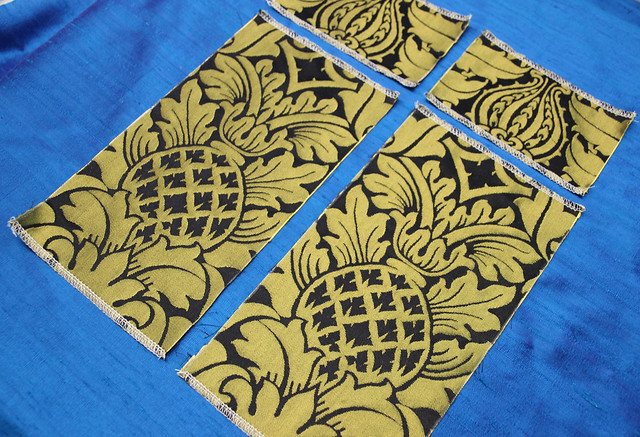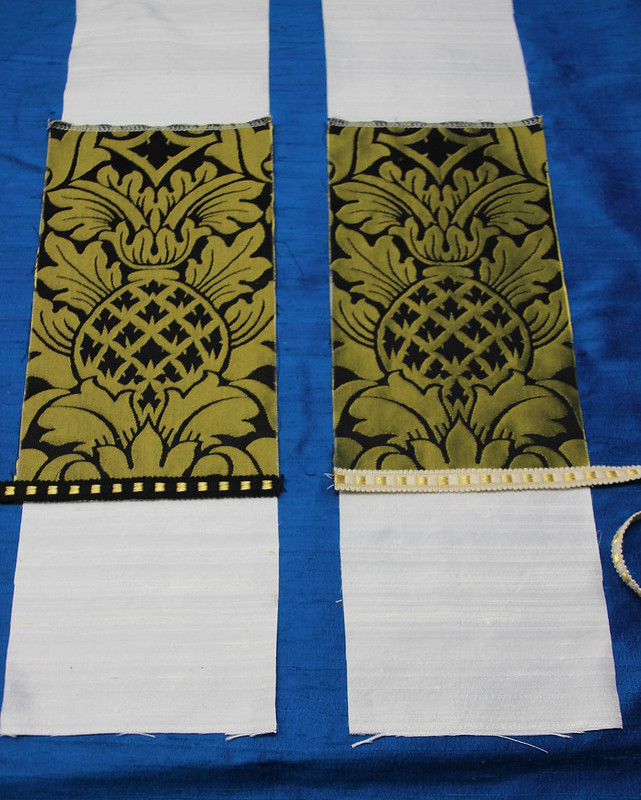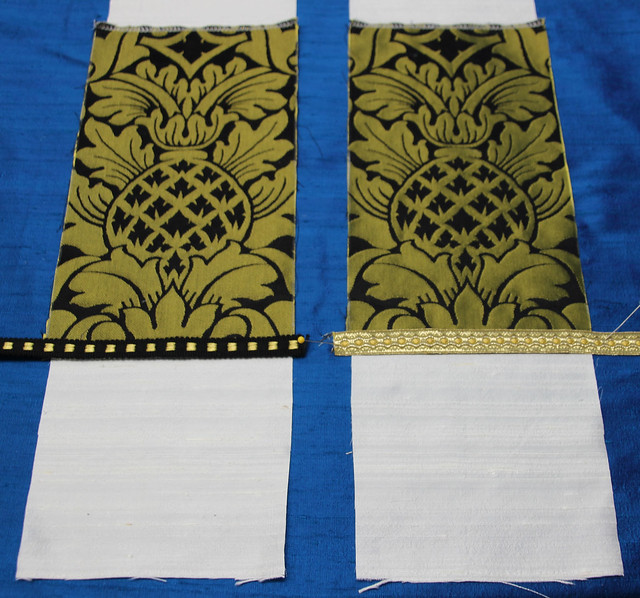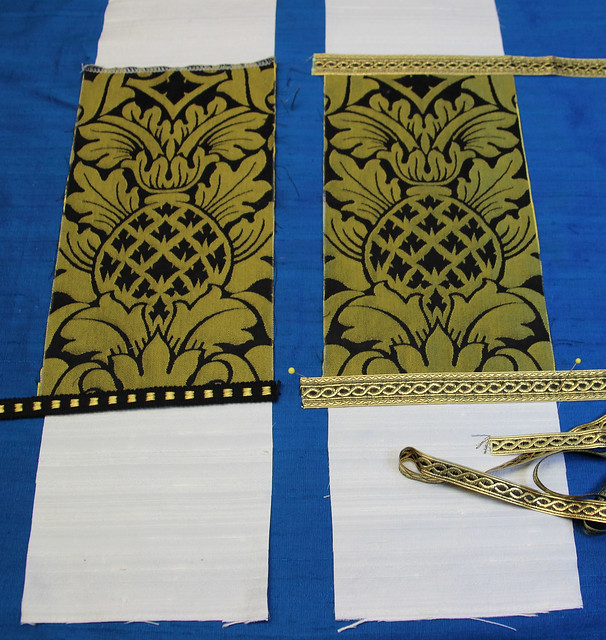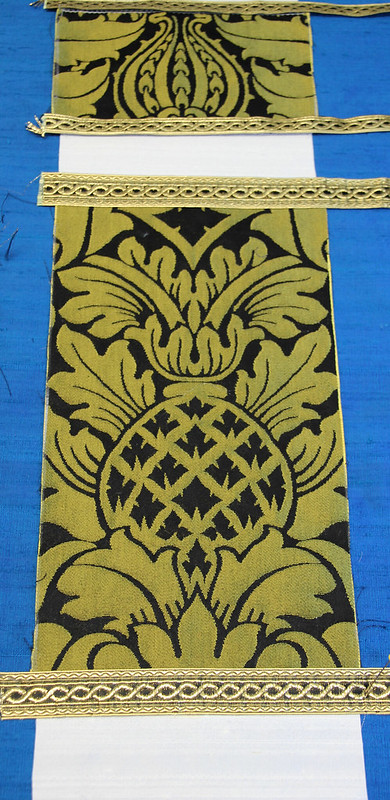“Details” is one of those words that can be embraced to take an Ecclesiastical Sewing project from the ordinary to the extraordinary. Taking the time to add an extra touch or to ensure a curve hits are just the right spot, or that a seam is sewn straight can make all of the difference in the world to a finished church vestment project. And there are other times when details may not matter in the least. The important thing is learning which details are important and crucial to make a church vestment look great, which are nice but not absolutely needed, and which are fine to be left out.
For today, we will look at details which are important when making a pastoral stole. In my last post on using Orphrey Bands, we left off with surging the upper and lower edge of the orphrey band in preparation for applying it to the stole base fabric. Many of the liturgical fabrics use a satin or twill weave which can ravel. Serging the edge of orphrey bands ensures the fabric remains neat and tidy, and stray ends remain under control. It also ensures that as the garment is worn and used, it does not pull over time and fray, which could result in ruining a stole long before its useful life is over. If you do not have a serger, there are other options available for finishing the edge which we can discuss later when we reach the construction phase of stole making. Finishing the edges of orphrey bands prior to applying them to a base fabric is important, and should not be forgotten.
Liturgical Trims
And now the fun begins. I often start by laying a stole end out on the cutting table, or on the photo board and start trying out different trim options (provided I have a few trims on hand). Now, before we delve into the topic of trims and get carried away with “finding that perfect trim,” let’s pause for a moment and put things in perspective. Trims are important, but there are many options that will accomplish the same objective. The purpose of the trim is two-fold: first, it is used to cover the raw edge of the orphrey, or to hide a seam, and second, it is used as a decorative element. While the use of trims is a wonderful way to accomplish these objectives, it is not the only option, and it should not become something to obsess over. If time and budget allow, order one or two trim options, use the best, and save the other for a future project. If budget does not allow for purchasing more than one trim, select a more “standard” trim rather than worrying over locating something more special. We will also try to look at alternative options to using trims at a later time.
There are a few Ecclesiastical Trims and Ecclesiastical Braids that are my favorite go-to trims. (On a side note, the trim photos for the new website are looking very nice!) The above photo shows Dice Trim in the Black/Gold as well as Ivory/gold. Dice trim is a braid that features tiny “cubes” of gold and solid color that alternate along the length of the trim. It is a neat, clean, tailored trim that looks handsome and attractive with many fabrics. Dice trim comes in all of the standard liturgical colors: Black, Ivory, Rose, Gold, Blue, Green, Red, Violet, and Multi.
Notice that I have placed the Black/Gold Fairford Brocade on a white silk dupioni silk. You may be wondering if black accents are used on white vestments. And the answer is yes. This can be a stunning look when properly proportioned. The Black and Ivory Dice trim have been laid on the vestments. The black dice trim really looks stunning, while the Ivory does not work as well. So black dice trim is a possibility.
Next on the list is gold St. Paul Braid. This is a nice option. The St. Paul braid has a bit of that “antique gold” color that works well with the gold background of the Fairford. I would use this trim on the stole, except that I do not have enough on hand. So, moving on………..
The trim on the right in the above photo is St. Benet Black/Gold in the 1 inch size. This also looks stunning with the Black/Gold Fairford Brocade.
I still do not have enough on hand to use the 1 inch Black/gold St Benet braid on a stole, but there is a coordinating 1/2 inch piece of St. Benet in the Black/Gold. Since the orphrey on the chest area of the stole is not as wide as the bottom orphrey, the 1/2 inch braid is the perfect size to use on the top of the stole, and the 1 inch braid works for the larger orphrey at the bottom of the stole. It is often nice to visually weight the heavier items as one moves to the lower edge of the stole. If I had enough yardage on hand, I could also use either the 1/2 inch size for the entire stole, or the 1 inch size for the entire stole.
Whether the Black/gold Fairford is placed on a white stole, or a black stole, the St. Benet Black/gold trim is an excellent choice for either colored stole, as is the Black Dice trim, or the Gold St. Paul Braid. The final deciding factor when selecting trims for making church vestments may come down to price, which is a topic for another post. And now that my decisions are made, it is time for some sewing of stoles. Until next time.
Solo Dei Gloria
Be sure to visit our online store front Ecclesiastical Sewing where you may shop for Liturgical Fabrics, altar linen fabrics, church vestment making patterns, liturgical machine embroidery designs, church vestment trims and notions and so much more. You may also find us on Ecclesiastical Sewing on Facebook , Twitter, and Pinterest. Sing up for our mailing list at the bottom of the page on our online store front and receive a free copy of our Small Linens Booklet as our way of saying thank you for following along.
Filed under: Ecclesiastical Sewing Tagged: Church Vestment, Ecclesiastical Sewing, Fairford Brocade, liturgical trims, Orphrey bands, pastoral stole

